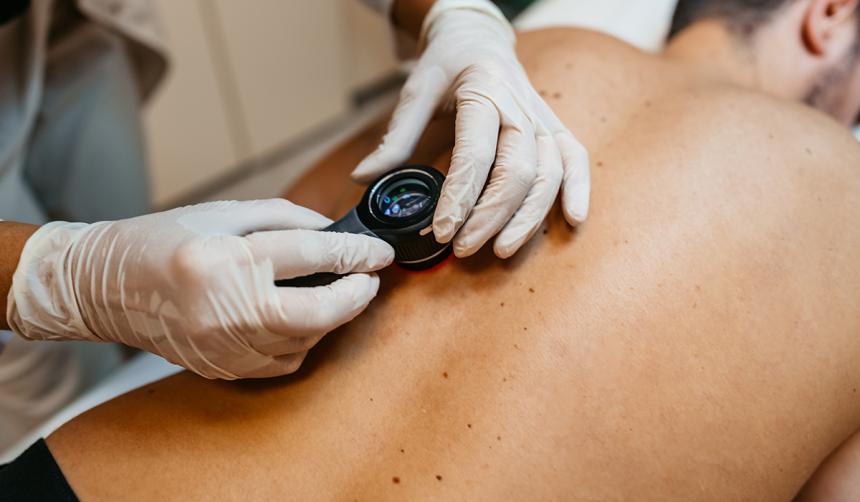The Four Types of Skin Cancers

Skin cancer occurs when damaged DNA causes abnormal cell mutations to grow indiscriminately and uncontrollably in the epidermis, the outermost skin layer. These cells can rapidly multiply forming malignant, cancerous tumors.
According to the Skin Cancer Foundation, the sun’s harmful ultraviolet (UV) rays and the intense UV light of tanning beds are the two primary causes of skin cancer. There are four main types:
1. Basal cell carcinomas (BCC)
BCCs are the most common form of skin cancer with around 3.6 million cases diagnosed annually in the U.S. Caused by prolonged or cumulative exposure to the sun’s harmful UV rays, BCCs are uncontrolled growths that originate from the basal cells in the epidermis, and most frequently occur on the face, neck, ears, scalp, back and shoulders. These areas are most commonly unprotected from the sun. If not diagnosed and treated early, BCCs can cause destruction to the localized skin area. Occasionally they can spread or metastasize, but they are only rarely fatal.
2. Squamous cell carcinoma (SCC)
SCCs are the second most common cause of skin cancer, with approximately 1.8 million diagnosed annually in the U.S. They manifest when abnormal cells grow uncontrollably from squamous cells in the epidermis and, like BCCs, are most common on skin areas typically exposed to the sun, including the scalp, ears, face, neck and hands. Like BCCs, SCCs are caused by long-term, cumulative exposure to the sun and tanning beds’ UV radiation. If not detected early, they can also grow rapidly and metastasize.
3. Melanoma
Of these three most common forms of skin cancer, melanoma is the most dangerous. According to the American Cancer Society (ACS), only about 1 percent of skin cancers diagnosed annually in the U.S. are melanomas, but they cause the majority of skin cancer deaths. The most recent 2023 estimates for new melanoma diagnoses are 100,640 (ACS) to 186,680 (Skin Cancer Foundation), with 89,070 cases being noninvasive (in situ) and 97,610 being invasive. Invasive melanomas penetrate the epidermis to the dermis. Melanomas cause an estimated 7,990 deaths, per the Skin Cancer Foundation.
Both intense intermittent sun exposure that results in sunburn and tanning bed use increases your risk for melanoma.
To detect melanoma early, it’s important to know your ABCDEs, the clinical rules to assess early detection:
A: Asymmetry – half of the spot is unlike the other half
B: Border – it has an irregular, ill-defined or scalloped border
C: Color – it varies in color across its area
D: Diameter – its diameter is more than 6 millimeters
E: Evolves – the spot is evolving, changing in size, shape, texture or color
4. Merkel cell carcinoma (MCC)
MCC is an aggressive but rare skin cancer tumor associated with a virus called the Merkel cell polyomavirus. It presents as painless, firm nodules or lesions on skin areas exposed to the sun, with half of cases occurring on the eyelids, head and neck. Early detection and treatment are crucial as MCCs have a high risk of metastasizing throughout the body and recurring. With rates expected to rise, there are approximately 3,000 new cases and 700 deaths annually in the U.S. from MCC. They are treatable when caught early, but can progress rapidly and become increasingly difficult to treat, so it’s critical to know your risks and recognize the warning signs covered by the following AEIOU early detection acronym:
A: An Asymptomatic lesion that is neither tender nor painful
E: The lesion Expands rapidly
I: You are Immuno suppressed
O: You are Older than 50
U: The lesions occur on UV-exposed skin
Most skin cancers can be detected, treated and often eliminated with little or no scarring. But you need to perform an annual full body check – including your scalp and between your toes. Schedule an appointment at your first sign of concern with your primary care physician or dermatologist.
If you have any concerns that a spot appears unusual or checks at least three ABCD or AEIOU signs and risks, see your doctor right away.
